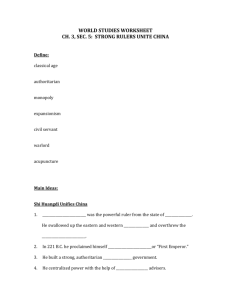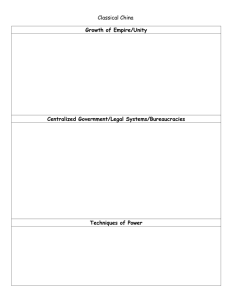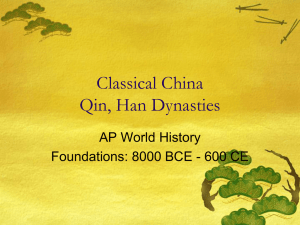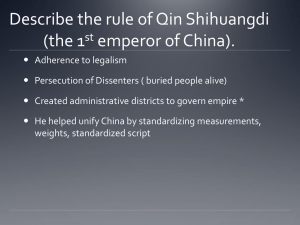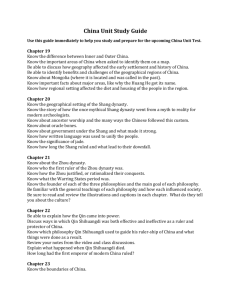Lesson 3 The Qin and the Han
advertisement
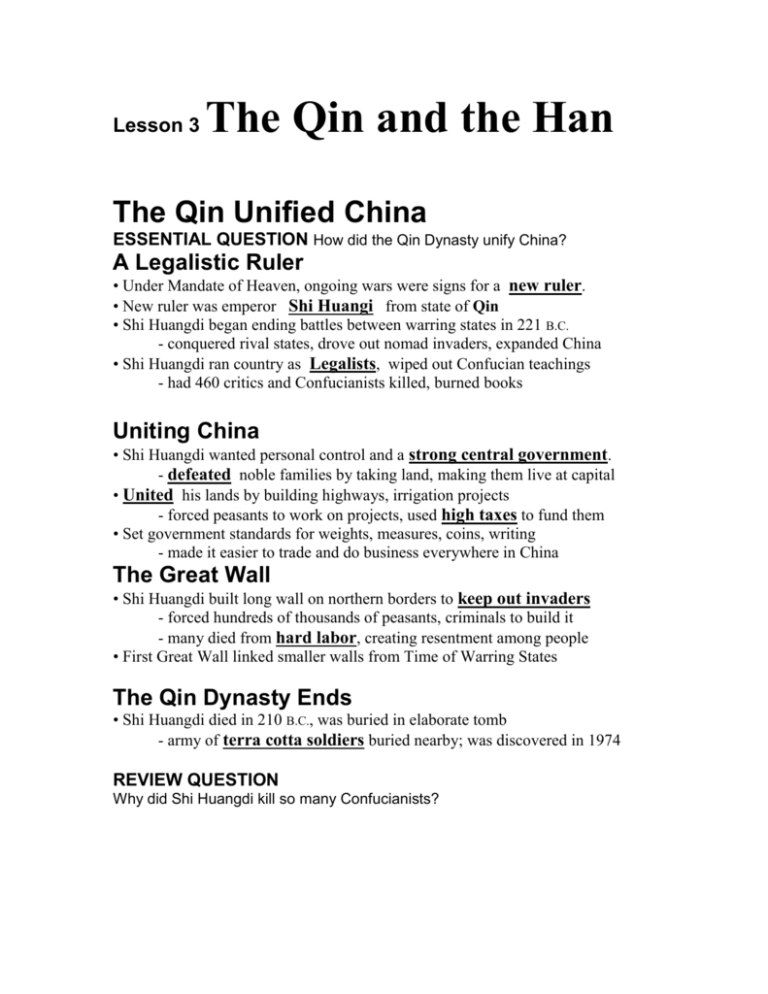
Lesson 3 The Qin and the Han The Qin Unified China ESSENTIAL QUESTION How did the Qin Dynasty unify China? A Legalistic Ruler • Under Mandate of Heaven, ongoing wars were signs for a new ruler. • New ruler was emperor Shi Huangi from state of Qin • Shi Huangdi began ending battles between warring states in 221 B.C. - conquered rival states, drove out nomad invaders, expanded China • Shi Huangdi ran country as Legalists, wiped out Confucian teachings - had 460 critics and Confucianists killed, burned books Uniting China • Shi Huangdi wanted personal control and a strong central government. - defeated noble families by taking land, making them live at capital • United his lands by building highways, irrigation projects - forced peasants to work on projects, used high taxes to fund them • Set government standards for weights, measures, coins, writing - made it easier to trade and do business everywhere in China The Great Wall • Shi Huangdi built long wall on northern borders to keep out invaders - forced hundreds of thousands of peasants, criminals to build it - many died from hard labor, creating resentment among people • First Great Wall linked smaller walls from Time of Warring States The Qin Dynasty Ends • Shi Huangdi died in 210 B.C., was buried in elaborate tomb - army of terra cotta soldiers buried nearby; was discovered in 1974 REVIEW QUESTION Why did Shi Huangdi kill so many Confucianists? The Han Dynasty ESSENTIAL QUESTION How did the Han rule China? The Han Replace the Qin • Civil war broke out at the end of the rule of Shi Huangdiʼs son - General Lui Bang defeated the Qin, ended the war, reunified China • Lui Bang began Han Dynasty—lasted from 202 B.C. to about A.D. 220 Han Government • Lui Bang kept strong government, lowered taxes, less harsh punishments - had peasants build roads, canals, irrigation system • Set up Bureaucracy—chosen officials ran offices, bureaus - officials were often Han family members and trusted people • To find officials, they gave people system of tests on Confucianism - tests helped select educated, ethical people for bureaucratic state Empress Rules • Lui Bang died in 195 B.C.; his widow, Empress Lü, ruled for her son - outlived her son, kept power by placing infants on the throne - died in 180 B.C.; all her relatives were executed. Expanding the Empire • Wudi, known as the Martial Emperor, ruled from 141 to 87 B.C. - wars expanded borders to south China, north Vietnam, north Korea • Han stayed in power despite rebellions, revolts, floods, famines REVIEW QUESTION How did the Han rulers find people for government jobs? Life in Han China ESSENTIAL QUESTION What was life in Han China like? Daily Life in Han China • Much of Han society lived in villages, worked on farms - most lived in one or two-story mud houses - rich farmers used oxen to pull plows; poor pulled plows themselves - simple clothing included clothes stuffed like a quilt for cool months • Raised wheat, millet in north; raised rice in south • Fish, meat were expensive so most people ate them in small portions City Living • Han cities were centers of trade, education, government • Cities were crowded with merchants, craftspeople, government officials • Entertainment included musicians, jugglers, acrobats • Some writers say the cities also had street gangs REVIEW QUESTION How were the lives of farmers different from those of city dwellers? Lesson Summary • In 221 B.C., the Qin ruler Shi Huangdi unified China and ruled by harsh Legalist principles. • The Han Dynasty ruled over a large and successful land. • The Han Chinese way of life is reflected in Chinese life today. Use the Bubble Map below to compare/contrast the Qin & Han Dynasties. QIN HAN
